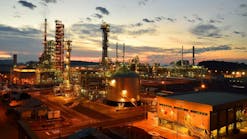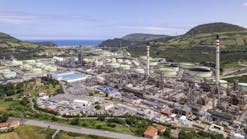HPCL lets contract for Visakh refinery revamp
Hindustan Petroleum Corp. Ltd. (HPCL) has let a contract to KBR Inc. to provide technology for a unit to be added as part of HPCL’s previously announced program to expand and modernize its 166,700-b/d Vishakhapatnam (Visakh) refinery in Andhra Pradesh on India’s southeastern coast (OGJ Online, Mar. 21, 2017).
Under the contract, KBR will license its residual oil solvent extraction (ROSE) solvent deasphalting (SDA), which will be integrated with the LC-MAX technology ebullated-bed residue upgrading process from Chevron Lummus Global (CLG), the service provider said.
Specifically, KBR will deliver CLG the technology licensing, basic engineering design, and proprietary equipment for the ROSE SDA portion of the LC-MAX unit.
KBR disclosed neither a value nor timeframe for the contract.
As part of the Visakh refinery modernization project (VRMP), HPCL previously let a contract to L&T Hydrocarbon Engineering Ltd. to provide engineering, procurement, construction, and commissioning for a 70,300-b/d residue upgrading facility to be equipped with technology licensed by CLG that will enable HPCL to convert the heaviest oils into high-quality Euro 6 diesel while simultaneously eliminating fuel oil production, as well as increasing feedstock and product flexibility (OGJ Online, Oct. 23, 2019).
Since project approval in January 2016, HPCL has let multiple contracts for the brownfield VRMP, which proposes to expand refining capacity of the site to more than 300,000 b/d as well as boost production of low-sulfur fuels conforming to Euro 5 and Euro 6-quality standards (OGJ Online, Mar. 29, 2019).
VRMP overview
According to India’s Ministry of Environment, Forest, and Climate Change, HPCL’s originally proposed 208 billion-rupee VRMP was to add the following units at the refinery:
• A 180,700-b/d CDU-VDU, which will replace one of Visakh’s three existing CDUs.
• A 66,300-b/d full-conversion, vacuum gas oil hydrocracker.
• A 5,860-b/d naphtha isomerization unit.
• A 62,250-b/d solvent deasphalting unit.
• A 50,200-b/d slurry hydrocracker.
• A 96-tonne/day propylene recovery unit (PRU), which will replace an existing 216-tonne/day PRU.
• Two 113,000-tpy hydrogen generation units (226,000 tpy total).
• Two 360-tonne/day sulfur recovery units (720 tonnes/day total, including tail gas treatment).
• A 36,000-tpy fuel gas pressure-swing adsorption unit.
• A 300-tonne/hr nonhydroprocessing sour-water stripper.
• A 185-tonne/hr hydroprocessing sour-water stripper.
• Two 540-tonne/hr amine regeneration units (1,080 tonnes/hr total).
• A 112,000-tpy sulfur recovery LPG treating unit.
• A 1,000-cu m/hr integrated effluent treatment plant (EFP), which will replace all existing EFPs at the site.
According to the latest project information available from HPCL and general contractor Engineers India Ltd., major processing units at the refinery are scheduled for revamp as follows:
• A 30% capacity expansion of the naphtha hydrotreater in the refinery’s Motor Spirit (MS) block to 30,120 b/d.
• A 35% capacity expansion of the continuous catalytic reforming unit in the MS block to 20,890 b/d.
• A 30% capacity expansion of the diesel hydrotreating unit to 57,430 b/d.
• An upgrade of the naphtha hydrotreater downstream of the refinery’s fluid catalytic cracker to enable output of BS V and BS VI-grade (equivalent to Euro 5 and Euro 6-quality) fuels.
The 209.28-billion rupee VRMP remains on schedule for mechanical completion in July 2020, according to HPCL’s web site.
Contact Robert Brelsford at [email protected].

Robert Brelsford | Downstream Editor
Robert Brelsford joined Oil & Gas Journal in October 2013 as downstream technology editor after 8 years as a crude oil price and news reporter on spot crude transactions at the US Gulf Coast, West Coast, Canadian, and Latin American markets. He holds a BA (2000) in English from Rice University and an MS (2003) in education and social policy from Northwestern University.


